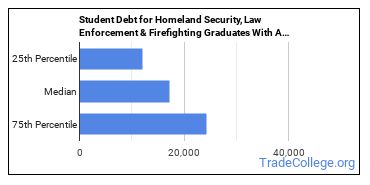Associate Degrees in Homeland Security, Law Enforcement & Firefighting
Featured schools near , edit
Education Levels of Homeland Security, Law Enforcement & Firefighting Majors
During the 2021-2022 academic year, 33,718 students earned their associate degree in homeland security, law enforcement & firefighting. The following table shows the number of diplomas awarded in homeland security, law enforcement & firefighting at each degree level.
| Education Level | Number of Grads |
|---|---|
| Bachelor’s Degree | 59,550 |
| Associate Degree | 33,718 |
| Basic Certificate | 26,306 |
| Undergraduate Certificate | 6,956 |
Earnings of Homeland Security, Law Enforcement & Firefighting Majors With Associate Degrees
The median salary for graduates holding an associate degree in homeland security, law enforcement & firefighting is $30,251. A lot of factors can contribute to this number, such as the location of your workplace and the availability of other perks and bonuses. A better approximation of salary is to look at the typical range of salaries. In this case the low is $26,047 and the high is $36,371.

Student Debt
The median student debt for graduates holding an associate degree in homeland security, law enforcement & firefighting is $14,000. The length of time it takes you to graduate and what college you attend can affect this number quite a bit. The chart below shows the range of accumulated debt loads. On the high side of the range, $20,000 is the debt load, and the debt load on the low side is $11,000.

The median monthly payment of a homeland security, law enforcement & firefighting graduate with a 10-year repayment plan is $119.
Student Diversity
More men than women pursue associate degrees in homeland security, law enforcement & firefighting. About 51.3% of graduates in this field are male.
| Gender | Number of Grads |
|---|---|
| Men | 17,292 |
| Women | 16,426 |

The racial-ethnic distribution of homeland security, law enforcement & firefighting associate degree students is as follows:
| Race/Ethnicity | Number of Grads |
|---|---|
| Asian | 943 |
| Black or African American | 3,963 |
| Hispanic or Latino | 11,452 |
| White | 14,353 |
| International Students | 151 |
| Other Races/Ethnicities | 2,856 |

Homeland Security, Law Enforcement & Firefighting Majors to Study
| Major | Annual Degrees Awarded |
|---|---|
| Criminal Justice & Corrections | 28,100 |
| Fire Protection | 4,148 |
| 850 | |
| Homeland Security | 462 |
| Other Homeland Security | 158 |
Explore Major by State
Alabama
Arkansas
Connecticut
Florida
Idaho
Iowa
Louisiana
Massachusetts
Mississippi
Nebraska
New Jersey
North Carolina
Oklahoma
Rhode Island
Tennessee
Vermont
West Virginia
References
*The racial-ethnic minority student count is calculated by taking the total number of students and subtracting white students, international students, and students whose race/ethnicity was unknown. This number is then divided by the total number of students at the school to obtain the percentage of racial-ethnic minorities.
- College Factual
- National Center for Education Statistics
- O*NET Online
- Bureau of Labor Statistics
- Image Credit: By Barry Bahler under License
More about our data sources and methodologies.
Featured Schools
 Request Info
Request Info
|
Southern New Hampshire University You have goals. Southern New Hampshire University can help you get there. Whether you need a bachelor's degree to get into a career or want a master's degree to move up in your current career, SNHU has an online program for you. Find your degree from over 200 online programs. Learn More > |
